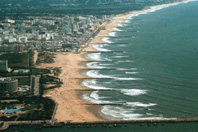
Groynes (or, groin) and shadow. Photo source: ©© Andrew Tijou
By Coastal Care;
North Carolina law (G.S 113A-115.1) prohibits the use of groins – steel, rock or wood walls built perpendicular to the beach in order to trap shifting sand – and other permanent erosion control structures along ocean shorelines. This ban is based on: 1) extensive studies and technical data documenting the detrimental impacts of erosion control structures and 2) 150 years of documentation of the negative impacts of shoreline stabilization on the barrier islands in New Jersey.
The negative impact of groins on downdrift shorelines is well understood. When a groin works as intended, sand moving along the beach in the so-called downdrift direction is trapped on the updrift side of the groin, causing a sand deficit and increasing erosion rates on the downdrift side. This well-documented and unquestioned impact is widely cited in the engineering and geologic literature.
The United States Army Corps of Engineers’ Coastal Engineering Manual describes groins as: “…probably the most misused and improperly designed of all coastal structures…Over the course of some time interval, accretion causes a positive increase in beach width updrift of the groin. Conservation of sand mass therefore produces erosion and a decrease in beach width on the downdrift side of the groin” (USACE, 2002). In his textbook (used by most coastal engineering programs to introduce beach processes) Paul Komar, professor emeritus in the College of Oceanographic and Atmospheric Sciences at Oregon State University, states, “Groins and jetties have the same effect in damming the longshore sediment transport, the shoreline builds out on the updrift side and erodes in the downdrift direction” (Komar, 1998). There is no debate. Groins cause downdrift erosion.
While the extent, degree and duration of negative impacts can not always be accurately predicted, a groin placed at the terminus of a barrier island, near an inlet, interrupts the natural sand bypass system. This deprives the ebb and flood tide deltas of sand and can cause substantial negative impacts to adjacent Islands. In a complex coastal system, the precise location, onset and scale of these negative impacts are very difficult to pinpoint. As with all erosion control structures, it may take years for groin impacts to become apparent. This is why promises to monitor such projects ring hollow, and why disputes over groin impacts often end up in court where judges, rather than scientific experts, end up making critical coastal management decisions.
Using groins in conjunction with beach nourishment projects is of dubious value as well. When big storms occur, groins direct strong currents that carry large amounts of sand seaward, in an offshore direction parallel to the groins. After Hurricane Hugo, for example, sidescan sonar studies showed gullies excavated on the continental shelf adjacent to each of the groins on Pawleys Island in South Carolina. Because much sand loss is offshore during storms, groins will have little impact on holding sand in place (and may even accelerate loss).
The implication by those who are promoting the law to allow the use of groins on North Carolina ocean and inlet shorelines is that this is experimental and that if the groins don’t work they will be removed or altered. There is nothing experimental about groins. It is clear that on a shoreline where sand is transported laterally, groins will always cause erosion. The only questions are where and when will this erosion occur. Experience on many other American shorelines indicates that removal of a groin, once it is put in place, is a rare event no matter what promises are made beforehand.
The localized and temporary updrift benefits afforded by groins rarely, if ever, justify the downdrift damage caused by increased erosion – regardless of whether it is to developed or undeveloped shorelines, inlets and islands. We urge you to maintain the State of North Carolina’s high standards for coastal management by preventing any change to the current ban on coastal hard structures. Doing so is the surest way to protect our state’s beaches for future generations.
Thank you for your time and consideration.
Sincerely,
- Rob Young, PhD, P.G., Professor of Geosciences, Western Carolina University
- Orrin Pilkey, PhD, James B. Duke Professor Emeritus of Geology, Duke University
- Duncan Heron, PhD, Professor Emeritus of Geology, Duke University
- Stan Riggs, PhD, Professor Emeritus of Geology, East Carolina University
- David Mallinson, PhD, Assistant Professor of Marine Geology, East Carolina University
- David Bush, PhD, P.G., Professor of Modern Sedimentology, University of West Georgia
- Len Pietrafesa, PhD, Director of External Affairs for the College of Physical and
- Mathematical Sciences, North Carolina State University
- Art Trembanis, PhD, Assistant Professor, Department of Geology, University of Delaware Michael Fenster, PhD, Director of Environmental Studies, Randolph-Macon College
- James F. Fox, PhD, Director of Operations, National Environmental Modeling and Analysis Center, UNC Asheville
- Charles Fletcher, PhD, Professor and Chair, Department of Geology, University of Hawaii
- Paul T Gayes, PhD, Director, Center for Marine and Wetlands Studies,
- Coastal Carolina University
- Andrew Coburn, Research/Graduate Faculty & Associate Director,
- Program for the Study of Developed Shorelines, Western Carolina University
- David Levinson, Physical Scientist, Climate Monitoring
- Dorothea Ames, P.G., Assistant Scientist, East Carolina University
- Laura J. Moore, PhD, Assistant Professor, Department of Geology, Oberlin College
- Nicholas Coch, PhD, Professor of Earth & Earth Science, Queens College, CUNY
- H. Allen Curran, PhD, Kenan Professor of Geology, Smith College
- Jon C Boothroyd, PhD, Professor of Quaternary Geology, University of Rhode Island
- Joe Kelley, Chair, PhD, Dept of Earth Sciences, University of Maine @ Orono
- Hal Wanless, PhD, Chair, Department of Geology, University of Miami
- Andrew Cooper, PhD, Professor of Coastal Studies, University of Ulster
- Donald Barber, PhD, Director of Environmental Studies, Bryn Mawr College
- Dr Michael Katuna, PhD, Professor of Geology, College of Charleston









